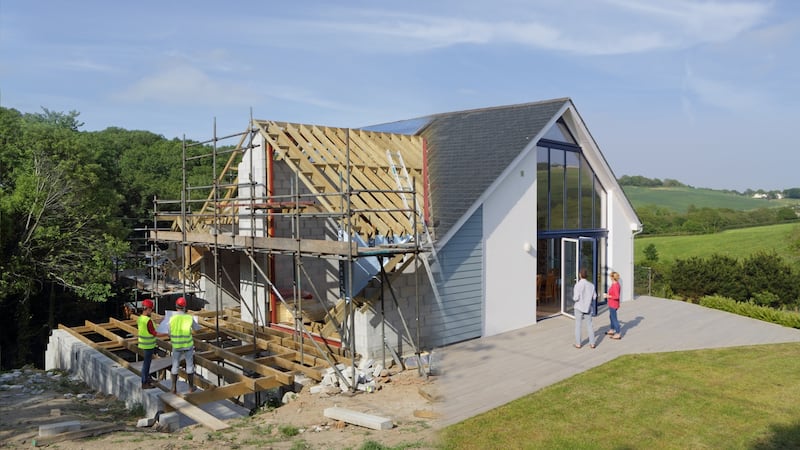1 Do your homework
To be in the know about upcoming new homes schemes, register your interest ahead of time with relevant agents to keep abreast of launch date viewings and developments. You will also need to have your financial house in order. Are you ready to sign a contract? If you are, you will need proof of finance and documents from your bank showing up-to-date loan approval.
"As a first-time buyer you are eligible for a contribution of 5 per cent of the purchase price or up to €20,000 towards the 10 per cent deposit required under the Help to Buy Scheme, which ends in December 2019. Go to revenue.ie to get an application number. Another option is the Rebuilding Ireland loan," says Gemma Lanigan, partner at DNG new homes.
If trading up and you see something you like before you sell your existing property, you need to talk to the selling agent, Lanigan says. “In a best-case scenario it will take eight to 10 weeks before you get a signed contract so you need to keep the lines of communication open. Most agents will work with the vendor to help you sell.” But some developers won’t sell to someone with a home to sell, so you may have to wait until phase two.
2 Additional costs

In addition to the purchase price of the property there are other costs to consider. The booking deposit is usually 2-5 per cent of the purchase price and payable once the offer has been accepted. It is fully refundable up to the point where contracts are signed. Factor in stamp duty: the rate is 1 per cent of the purchase price on properties up to €1 million and 2 per cent on figures above €1 million. A bank valuation will cost another €150 and a surveyor’s report another €500. Then there are solicitor’s fees; a flat fee or a percentage of the purchase price. Also allow for an annual service charge and multiply this outlay by the duration of the mortgage to get a clear view of the actual long-term cost.
3 Location

Visit the neighbourhood at different times of the day and night to get a feel for it, says Colm Byrne, director of new homes at Sherry FitzGerald. “Note what amenities are within walking distance. Are there GAA clubs, sports grounds? Where can you get a late-night or early morning pint of milk, for instance? Where is the nearest supermarket? Is there a neighbourhood restaurant where you can go for a bite to eat or a pub for a quiet drink?”
4 Transport links

Verify travel distances using Google – this is what most agents use as a guide – but don't take it as gospel. If driving there, double-check the mileage, timings and distances in your own car.
If buying within the Greater Dublin Area, invest in a large, up-to-date map of Leinster and physically pinpoint the location of each development you view to gain a proper overview of each site’s proximity to amenities and road, bus and rail commuter options.
Be sure to do a trial run of the commute at rush hour – some suburban rail stations are already extremely congested. Check if the transport falls within the affordable Short Hop commuter range, as that will affect commute costs.
5 Schools

Schools are becoming a big issue for would-be parents and parents of small children, Byrne says. “In some housing estates the catchment boundaries bisect the same street or road, so while agents will list the schools in an area, buyers need to do their own homework to find out if the development’s address falls within a certain school’s catchment area.
6 First impressions

On viewing day everything will be immaculate, says Muriel Simpson, associate director at House & Garden Furnishings. "So switch off lights to see rooms in real daylight. Look at the storage being offered; are there wardrobes in each bedroom, and if not, is there space for a wardrobe when you factor in a full-size bed? Are the landings generous enough to take a chest of drawers? Is there space under the stairs to build more storage?
Look at outside space, too. “Is there off-street parking? Where can you keep bins? Is there space out front for a bike box if buying a mid-terrace unit? What is the orientation of the back garden or balcony? Is it big enough to fit a shed or barbecue area?”
7 Design that works

Box bay windows and floor-to-ceiling glazing is beautiful to look at but once you install sofas, tables and chairs, you may find valuable light is blocked.
Check that interconnecting doors sit flush with the walls and that door handles don’t knock against handles on other doors. Equally check how far the guest toilet door swings into the hall. When open, is it a hazard?
Also note the overhead storage supplied in the kitchen, says Arlene McIntyre of Ventura Design. “Some are limited, so ask the kitchen supplier if it is possible to build out the supplied kitchen at a later stage.” This will come out of your own pocket.
Note the rise of stair treads, their width and headroom. This will become important when trying to wrestle chunky furniture up to a first or second floor.
8 Look up

Ask if the attic can be converted. Some new homes are designed with this in mind. Others are not. Most developers are pretty clear on this but those that are can be converted for about €35,000, making it a really affordable way to add accommodation.
9 Finishing touches

What kind of finish does the property have? Are the bathroom fixtures bog standard or is the developer offering more? At Rockville in Dublin 18, for example, the homes had very on-trend black doorware and black bathroom hardware as well as kitchens where buyers could choose from four customisable colours. Flooring in bathrooms and the kitchen often form part of the package, but check and double-check what is included in the sale, McIntyre advises.
10 Compare, contrast and snag list

Compare and contrast the various offerings at each development you view. Take a note of: proposed finishes, kitchen storage, countertops and brands in the appliance package, the number of bedrooms, built-in storage, overall square footage, number of bathrooms, rear access, locations for refuse, off-street parking, distance to shops and schools, bus or rail stops, ambient noise from overhead flight paths or busy roads and asking price. Mark each out of 10 and input the figures to an excel spreadsheet so at a glance the pros and cons of each property will be evident. This will help to arrive at a decision.
When you make your decision, you then need to do a comprehensive snag list, says Róisín Lafferty of Kingston Lafferty. “You should be allowed to review the property before final handover. Go through it room by room, checking the level of finish in the paintwork, kitchen and wardrobe joinery and in bathrooms check the tiling and that the plumbing and toilets work. Take photos of anything you are not happy with.”
11 Signing on the bottom line

To buy a property, you need to pay a booking deposit and show documents from your bank demonstrating up-to-date loan approval, Lanigan says. Her agency usually recommends three to four solicitors that have handled homes on that particular scheme because they usually offer a competitive rate, and are already familiar with the property and the issues that might arise. “This should expedite closing – developers are keen to close within 28 days, and most solicitors won’t pick up the file until the loan offer has been made.”













